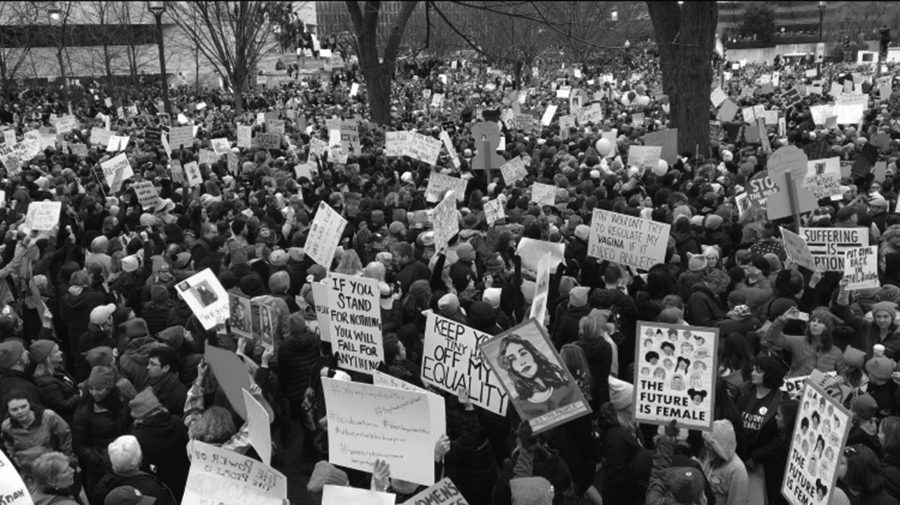Editorial: Why we march
January 26, 2017
On Saturday, Jan. 21, one day after the inauguration of Donald J. Trump as the 45th United States president, over 3 million people gathered at women’s rallies and marches around the world.
These marches were mostly organized by various activist groups and drew an estimated 500,000 women, men and children to Washington DC alone — the largest demonstration in the history of the capital. Millions of demonstrators showed support in New Orleans, Boston, Paris, Nairobi, Melbourne, Budapest and other cities across the globe.
Participants in these global demonstrations, including the Loyola students who traveled to the capital and attended events in New Orleans, should look proudly at this fact.
However, this unprecedented turnout is being questioned from every angle.
These challenges are mainly doubts from right-leaning citizens about a left-leaning protest and should not be unwelcomed. They are in the same vein as the protests, free political discourse that comes with territory.
The questions from protest detractors highlight the difficulty for people to understand their opposition. If answered, they can be telling about Americans and help explain why we march.
The following are quotes taken from various social media platforms and articles.
“What does protesting even accomplish?”
Data on these global protests is still being assessed, but the Women’s March will go down as one of the largest international protests to date.
Even if this were not the case, the historical significance of protest in America is explanation enough. “The right of the people peaceably to assemble” is of the utmost importance to American democracy. The country was founded on protest.
From boycotting British goods to revolution, the founding fathers were too wary of tyrannical government not to protect and encourage civil disobedience. Trump is not the British government, but the undying principle is the same.
Mass demonstrations are also the most centralized way for activists to unite and develop grassroots movements. During the Obama administration, the Tea Party started as a protest movement, leading to the Republican Party of today.
“What rights do you fear that Trump will actually take away?”
A laundry list of issues were addressed during these marches, jumping from immigration to prison reform to Trump’s cabinet picks. However, the overwhelming topic of these protests was reproductive rights.
Abortion took a backseat to the economy and national security this election cycle, but is the single most contentious social issue in America. For most of the election, “abortion” was within the top five Google searches with a candidate’s name. On Election Day, it was the most searched.
Protesters fear that the Trump administration and congressional Republicans will succeed in defunding Planned Parenthood. They also fear tighter restrictions on abortions on the state level and setbacks in the fight for covered female contraceptives, the deregulation of women’s bodies and more.
Trump is on record saying that women who receive abortions should have some form of punishment. In his first day in office, Trump signed a previously dead bill that bans all U.S. funding to organizations that offer abortion counseling or advocate for abortion in foreign countries.
“I do not support the women’s march because I am not a victim. Talk about the real issues that women around the world face.”
A popular sentiment amongst female protest detractors online, not being a victim refers to personal accountability without making excuses. The promotion of “real gender-based issues” means to privilege-check American feminists.
Accountability is an admirable quality no matter what, but this argument denies gender-based problems like the wage gap, violence against women and equal opportunity.
These issues are not imagined.
These are quantifiable trends within the United States using data from various government, law enforcement and private organizations that span back decades.
These trends have been tested time and time again. Are they universal? No. Can something like the wage gap be simplified down to “79 cents on the dollar?” Of course not. Have they been getting better? Yes, because of activism and political engagement like the Women’s March.
When one woman has not experienced these problems but chooses to ignore the millions who claim they have, it shows the empathy problem in America.
However, condescending an anti-victim argument does not help this problem.
Feminism literally means equality, but radical feminism has hijacked the word altogether. Radicals, like the anarchists who insight violence at protests, often get the most attention. They take away from the overall message, in this case, that equality anywhere is good for people everywhere.
“Stop being sore losers. Your candidate lost.”
This is a reoccurring theme amongst protest detractors on social media worth noting. When witnessing last weekend’s marches, many of those against the demonstrations chalked the Women’s March up to a reaction over Clinton’s loss.
While it is inevitable that many protesters were impassioned Clinton supporters, these international rallies were so much more complex than the issue of winning vs. losing.
It is also inevitable, in a massive, multi-motivated crowd that some protesters focused on their issues with the Electoral College. It is important to ask: if the election results were flipped, would they still feel this way?
Generalizing all protesters as sore losers is the same as labeling all liberals “snowflakes” and “crybabies” and all Trump supporters as racists and bigots.
Non-productive name-calling is all too frequent on both sides of the political spectrum. It offers an easy syllogism, an over-simplification about an opponent’s thought process that prevents people from learning more about each other.
“Watched the protest yesterday but was under the impression that we just had an election! Why didn’t these people vote?”
Hillary Clinton won the popular vote by a margin of 2.87 million ballots.








